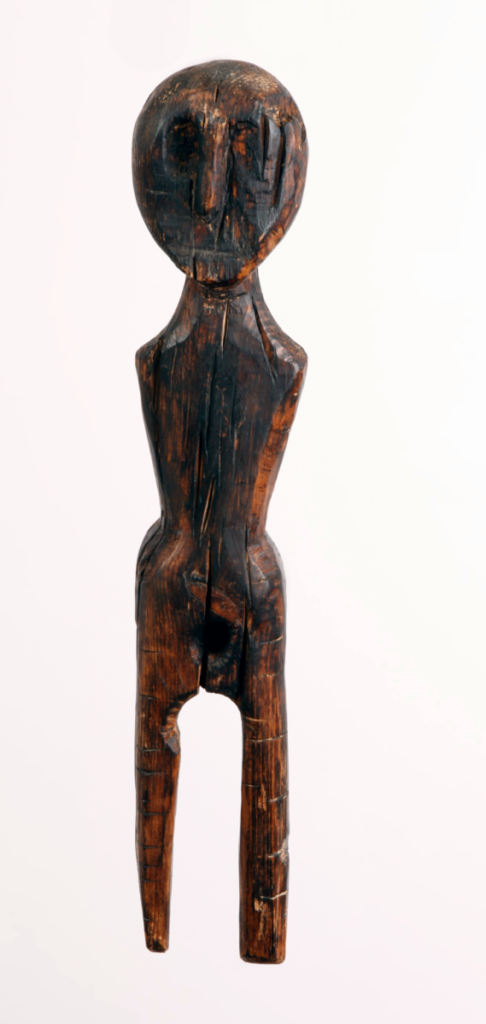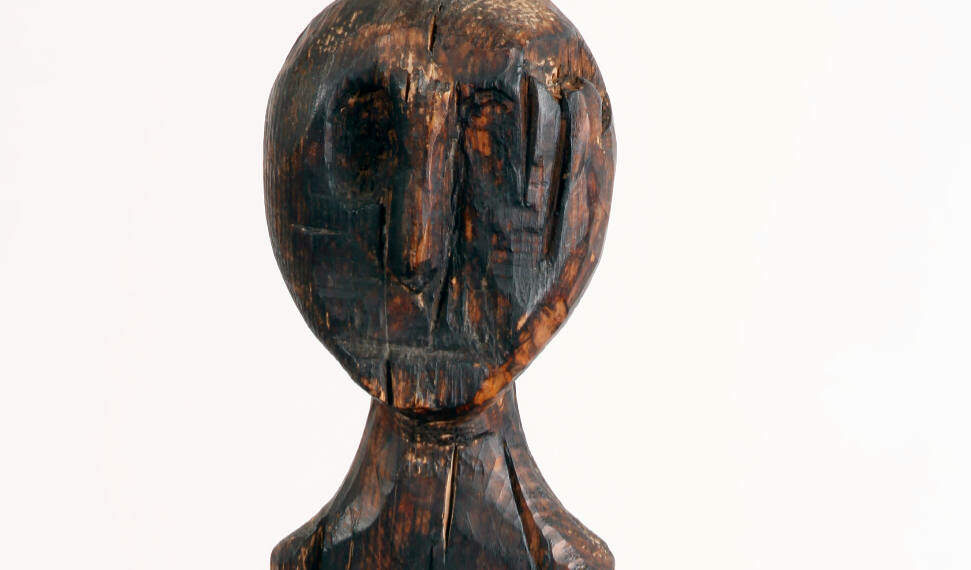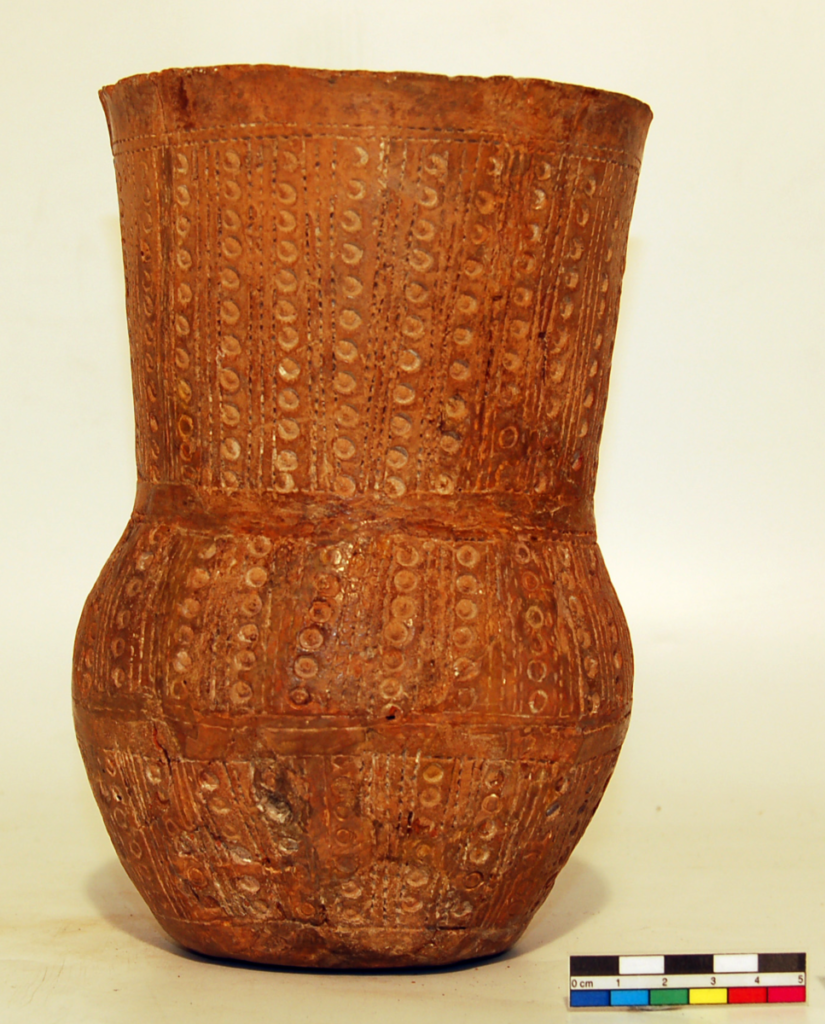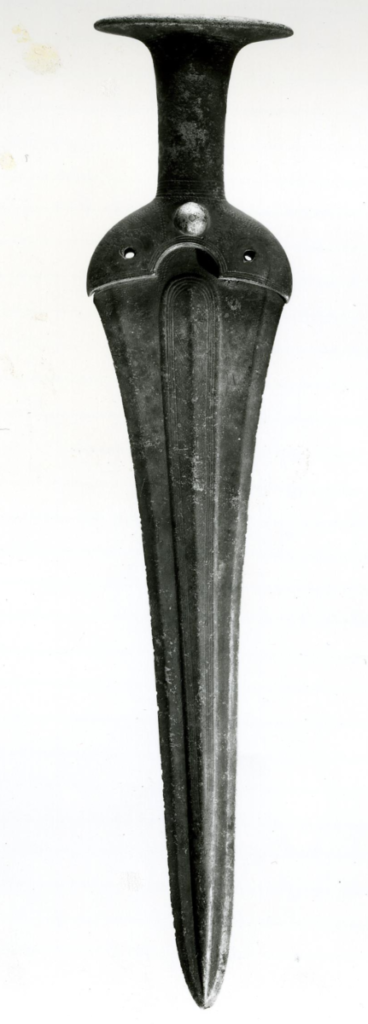About this find
Carved at a time of great change at the start of the Bronze Age, the Dagenham Idol is a wooden figure, over 4000 years old, with a large round head, and a body with two legs but no arms.
Archaeologists have dated it to 2459–2110 BC, which is when the Beaker People were living in this area.
Mysteriously, the figure’s left eye is deeply scratched. Some archaeologists think that the Dagenham Idol represents a god or goddess and that a skeleton of a deer, found next to it, shows that the animal had been killed as a sacrifice.
KEY FACTS
- FOUND: in 1922, by workers laying sewer pipes in marshland on the north bank of the River Thames and to the south of Ripple Road, Dagenham.
- NOW: Valence House Museum, on loan from the Colchester Castle Museum.
- MATERIAL: Wood - Scots Pine
- MADE: Radiocarbon dated to 2459 - 2110 BC (4200 years ago) During World War 2, Belhus house was badly damaged and was eventually demolished by Essex County Council (1957), which has since turned part of the parkland into a golf course and leisure facility.
TIMELINE:
Mesolithic
10,000-4,500 BC
Neolithic
4,500-2,300 BC
Bronze Age
2,300-700 BC
What other events were happening around the world at this time?
- 2500 BC, Egypt: Ancient Egyptians invented locks!
- 2300 BC, Iraq: the earliest records of marriage on Mesopotamian clay tablets.
Think like an archaeologist!
Look carefully at the Dagenham Idol. What questions do you have about it?
What?
Where?
Why?

© Valence House Museum
When?
How?
Who?
Think like and archaeologist:
Often, archaeologists cannot answer all the questions they have about an artefact.
Sometimes they can use science to find out how old it is or where it was made or what it was made from, but often archaeologists can only make sensible suggestions which are supported with evidence.
Archaeologists still have lots of unsolved questions about the Dagenham Idol. Why not tackle these ones in groups in your classroom?
Remember to explain your thinking!
I think that… because…
1) Do you think the Dagenham Idol is meant to be a god or goddess or a human? Why do you think that? What evidence do you have to support your ideas?
2) Why do you think the Dagenham Idol does not have arms?
Are they missing or were they even there in the first place?
What happened to them?
What could they have been made from?

© Valence House Museum
Challenge question:
Could the Dagenham Idol be the one-eyed Viking god Odin? Explain your thinking using your knowledge of British history.
How confident are you in your answers? Archaeologists often use words like may, perhaps, maybe, could, and possibly when they are feeling unsure.

© Valence House Museum
Helpful hints
The Vikings first invaded Britain in AD 793 but the Norse god Odin is first mentioned in Roman writing from around 2 BC.
But the Dagenham Idol was also buried at a time of change, when lots of people were arriving in Britain from different places in Europe and bringing new objects, technology, and skills with them like the ability to make tools and weapons from bronze.

The Beaker People made pottery beakers like this in the early Bronze Age.
© The Trustees of the British Museum
An early Bronze Age dagger made of copper alloy and found in the River Thames.
© The Trustees of the British Museum

Cross-curricular ideas for the classroom:��
WRITING: hot off the press!
It’s 1922 and workers laying sewer pipes have found the idol near the River Thames in Dagenham. Travel back to 1922 and imagine that you are a journalist reporting on the discovery of the idol. Can you write a newspaper front page with a snappy headline about the exciting new find? What about including alliteration and a few puns to grab your reader’s interest?
Fascinating fact: 1922 is the same year that newspapers around the world went wild with the discovery of Tutankhamun’s tomb in Egypt.
ART:
Why not draw or create your own version of the Dagenham Idol using craft materials or junk modelling? In real life it is 48 cm tall!
Maybe your model could include arms too!
SCIENCE:
how did radiocarbon dating and a peat bog help the archaeologists?
Radiocarbon dating helped archaeologists find out that the Dagenham Idol was an amazing 4,200 years old!
Radiocarbon dating works out how many radioactive carbon atoms there are in materials which were once alive or part of living things, like wood or bone.
A special machine counts the number of radioactive carbon atoms in an artefact. The fewer radiocarbon carbon atoms left, the older the artefact is!
Peat stopped oxygen from getting to the Dagenham Idol and rotting away the wood. If it hadn’t been buried in peaty, boggy, and waterlogged conditions, the idol would have decayed long ago long and become part of nature again.
Which of your favourite objects do you think would survive being in a bog for over 4000 years?



